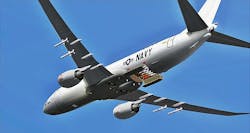Officials of the U.S. Naval Air Systems Command at Patuxent River Naval Air Station, Md., announced a $67.8 million contract to Boeing on Friday to integrate capabilities and training systems upgrades to the P-8A aircraft -- a variation of the Boeing 737-800 single-aisle passenger jetliner modified for maritime patrol and ASW.
Boeing engineers will upgrade the P-8A with high-altitude ASW weapons and sensors, as well as enable the aircraft to perform guided weapons in-flight target updates, retargeting, weapon hand-off, and bomb impact assessments over the Link-16 tactical radio network.
Related: Boeing to make flying torpedoes able to attack enemy submarines from 30,000 feet
Among the upgrades Boeing will perform is to equip the P-8A aircraft with torpedoes that can be released from altitudes as high as 30,000 feet. These high-altitude torpedoes are Navy Mark 54 lightweight torpedoes with add-n kits that enable the weapons to glide through the air to attack enemy submarines from long ranges.
Last year the Navy authorized Boeing to start building the add-on kits as part of the High Altitude Anti-Submarine Warfare Weapon Capability (HAAWC) Air Launch Accessory (ALA) program. Aircraft normally release conventional torpedoes from very low altitudes or with small parachutes to ease the torpedoes into the water gently.
The HAAWC ALA turns the Raytheon Mark 54 torpedo into a glide weapon that the P-8A aircraft can release from high altitudes. As the flying torpedo reaches the water, it jettisons wings and other air-control surfaces and takes on its original role as a smart torpedo that can detect, track, and attack enemy submarines autonomously.
Related: Navy Boeing P-8 maritime patrol jet to receive anti-submarine warfare (ASW) system upgrades
Ultimately, the Navy plans to buy 108 P-8A aircraft from Boeing to replace the service’s fleet of 196 P-3C Orion maritime patrol aircraft, which are approaching the end of operational life. The P-3 is a version of the Lockheed Martin Electra four-engine turboprop aircraft.
Last summer Boeing delivered its 15th P-8A Poseidon to Navy Patrol Squadron 16 at the Jacksonville Naval Air Station, Fla. P-8A squadrons and air crews will be based at Jacksonville NAS and at Whidbey Island NAS, Wash., where the squadrons will train for extended deployments.
Navy officials plan to use the P-8A in tandem with the Northrop Grumman RQ-4N Triton Broad Area Maritime Surveillance (BAMS) unmanned aerial vehicle (UAV) -- a maritime-patrol version of the Global Hawk long-range surveillance UAV.
One or more Triton UAV can detect and track hostile submarines, and the P-8A can launch torpedo attacks from high altitudes. Plans call for the P-8A to operate from high altitudes to save fuel, although the aircraft is hardened to operate at low altitudes.
Boeing is building the Poseidon aircraft at its factory in Renton, Wash. The 737 fuselage and tail sections will be built by Spirit AeroSystems in Wichita, Kan., then transferred to Renton where all structural features are incorporated in sequence during fabrication and assembly.
The P-8A’s flight management system and the stores management system have been developed by GE Aviation Systems in Grand Rapids, Mich. (formerly Smiths Aerospace). The cabin has as many as seven operator consoles.
The Poseidon’s MX-20HD digital electro-optical and infrared (EO/IR) multi-spectral sensor turrets come from L-3 Communications Wescam in Burlington, Ontario. The MX-20HD is gyro-stabilized and can have as many as seven sensors, including infrared, CCDTV, image intensifier, laser rangefinder, and laser illuminator.
The aircraft has the upgraded APS-137D(V)5 maritime surveillance radar and signals intelligence (SIGINT) system from the Raytheon Co. Space and Airborne Systems (SAS) segment in McKinney, Texas.
The APS-137D(V)5 radar, which is installed on the P-8’s enlarged nose fairing, provides synthetic aperture radar (SAR) for imaging stationary ships and small vessels, coastal and overland surveillance, and high-resolution imaging synthetic aperture radar (ISAR) for imaging surfaced submarines and fast surface vessels operating in coastal waters.
The P-8A will have the CAE Inc. advanced integrated magnetic anomaly detection (MAD) system. The Navy plans to arm the P-8A with the MK 54 torpedo.
On this contract Boeing will do the work in Seattle; St. Louis; and Patuxent River, Md., and should be finished by December 2017. For more information contact Boeing online at www.boeing.com/boeing/bds, or Naval Air Systems Command at www.navair.navy.mil.



